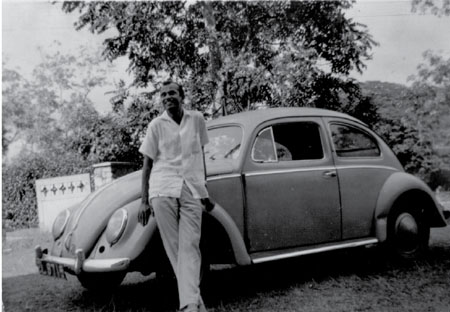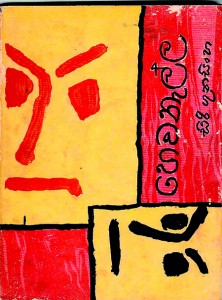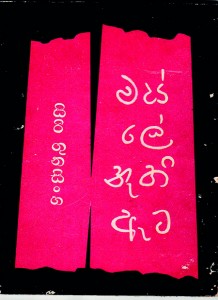Siri G – the affable rebel artiste

Those good old Peradeniya days: Siri G with his then ‘fashionable’ Volkswagon Beetle and (right) and (below) two books penned by him
He preferred to lead the way and face the music. It all started towards the end of 1956. He released his first collection of poems. The cover carried an unusual design – two blobs in red on a black background – one with the title of the book and the other with the author’s name. The verses did not follow the traditional style – they soon came to be known as ‘free verse’. Today it’s the style of most poets.
Prof. Siri Gunasinghe was the author. The book was titled ‘Mas le nethi eta’. It created an uproar. He was attacked particularly by those who were either writing poetry or enjoying the poems of the poets of the Colombo School. Being a university lecturer, he was branded as a promoter of the ‘Peradeniya School’. He was criticised for his style, his language and his subject matter. The unusual cover of the book was also designed by him.
Almost simultaneously, Siri G had designed the stage décor and costumes for ‘Maname’, Dr. Sarachchandra’s epoch-making ‘nadagama’. No one found fault with them. Neither was there much mention about it. As theatregoers, we noticed a difference – a novelty in them. After 50 years the same designs are maintained. Obviously there is no need to change – they are so unique. He designed costumes in Sarachchandra’s ‘Rattaran’ and ‘Kada Valalu’, Gunasena Galappatti’s ‘Sandakinuudru’ and P. Welikala’s ‘Ratnavali’.
And then he released his first novel – ‘Hevanella’ in 1960. It was different from the normal style in novels where the more classical type of Sinhala is used. He believed that there should not be a distinction between the spoken and written Sinhala. Write the way we talk, was his premise. Once again a barrage of criticism. He carried on regardless. 
Next was his rather unexpected entry into the film scene – the first university don to do so. Many eyebrows were raised when it was known that it was going to be something different. With its release in early 1967, the mood changed and he really came to be admired by everyone. The film was acclaimed by the critics, fans enjoyed it, and it won seven awards at the Sarasaviya Awards – the only awards presented at the time.
For the first time in local films, the accent was on the visual image rather than the dialogue. He picked known faces from stage – Cyril Wickremage, Denawaka Hamine and Edmund Wijesinghe for the lead roles and newcomers including Swarna Mallawarachchi who was soon to become a much-in-demand actress. D.B. Nihalsingha’s camera work with extreme close-ups and his editing, coupled with a superb music score by Somadasa Elvitigala, the theme song with beautiful lyrics by Mahagama Sekera sung with deep feeling by Amaradeva made it a memorable film. ‘Sath Samudura’ was among the ten best films of the first 50 years of Sri Lankan cinema.
Not many realised that Siri G – Best Director of 1967 – had studied filmmaking during a stint in the United States at the Department of Dramatic Art in the University of California. When he decided to try his hand at making a film, he believed that the film should not merely picturise a novel or a drama. It should be more cinematic than merely relating a story.
‘Sath Samudura’ brought together a fine team who wanted to give the audiences a quality, compelling film which could be enjoyed by all. And they did.
 Siri G also had an interest in painting. He came into the limelight when he exhibited his work at the Lionel Wendt Art Gallery at the end of 1967. He was into research too and made ‘Techniques of Indian Painting’, the subject of his post-graduate thesis. He authored the well-illustrated ‘An album of Buddhist Paintings – Kandy Period’ (1978) – a publication by the National Museums.
Siri G also had an interest in painting. He came into the limelight when he exhibited his work at the Lionel Wendt Art Gallery at the end of 1967. He was into research too and made ‘Techniques of Indian Painting’, the subject of his post-graduate thesis. He authored the well-illustrated ‘An album of Buddhist Paintings – Kandy Period’ (1978) – a publication by the National Museums.
My memories of him date back to the early 1950s when I first got to know him as a smart young lecturer (he taught Sanskrit) in the early days of the Peradeniya campus. As raw undergrads we naturally got closer to the young lecturers who were approachable and friendly. Sporting a short-sleeved white bush shirt enjoying a cigarette once in a way, we looked for his enchanting smile just as much as the occasional lift in his Volkswagon Beetle which was the ‘fashionable car’ among lecturers. His friendly nature made us feel so homely.
I was on the ‘Dinamina’ when ‘Maname’ was staged and used to frequently visit the Lionel Wendt where the first few shows were held. Invariably Siri G was there. Those also happened to be his courting days with Hemamali – one of the two Maname queens (the other was Trillicia) – whom he married and proceeded with to Canada.
We often met during the making of ‘Sath Samudura’. I was then with the ‘Observer’ and was actively involved in promoting Sinhala arts among the English speaking reading public, in keeping with editor Denzil Peiris’ policy.
On and off we used to meet when he visited Sri Lanka. I can’t remember meeting him after the launch of his novel ‘Miringuva Alleema’ in April 2002. The launch at the National Library Services auditorium turned out to be a lively one. As chief guest, Siri G had invited Professor J.B. Disanayaka – a staunch supporter of the school of thought that there should be a distinction between the spoken and written Sinhala. The audience enjoyed the viewpoints of both.
At the launch Siri G also commented on the approach to the whole aspect of culture. He said that culture now falls into two broad categories – song culture and teledrama culture. He even predicted the appointment of a ‘Professor of Songs’ in the universities. Lamenting that there is no longer any love for literature, he opined that meaningless novels were being dished out in the name of literature. He was critical of the language used in teledramas where there was absolutely no effort on the part of the scriptwriter to study the language that should be used to match the setting of the story. What is accepted as the spoken language in day to day life in the South will be used in a story set in the up-country creating a total mismatch. He had a word on literary criticism. Newspapers were no longer interested in critical appreciation of a literary work, he said.
With Dr. Siri Gunasinghe’s departure, the last of the Peradeniya dons who had a genuine interest in doing something meaningful in stimulating Sinhala arts is over. We, the oldies, will continue recalling the pleasant memories of our times.


